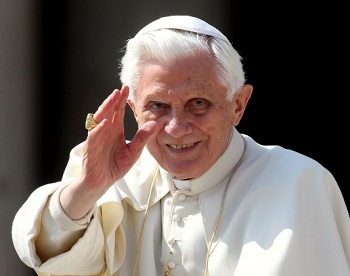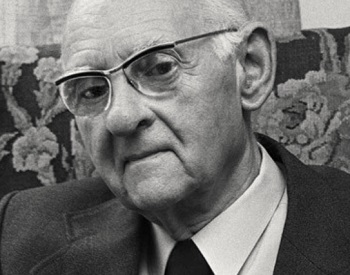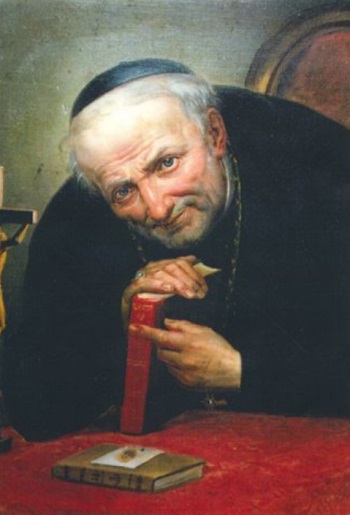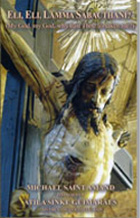Traditionalist Issues
 |
 |
 |
 |
 |
 |
 |
Dialogue Mass - CXXXVI
Burning the Manuals:
Knowledge of the Faith under Attack
Whenever we consider the various waves of damage inflicted on the Church by revolutionaries throughout her History, we tend to think in terms of real estate, like cathedrals, monasteries and parish churches, or the accoutrements of religious ritual, such as vestments, chalices etc. – and understandably so, as Maurice Barrès, a member of the Académie Française, wrote in 1914:
“Our churches are among the greatest treasures of civilization. We have received them from our ancestors; we have a duty to hand them on to our descendants; we must not allow ourselves to be confounded by those who declare them to be useless.”1
These words are, of course, self-evidently true, but need to be repeated again in our times when dioceses are selling or demolishing churches declared “useless” at a rate that rivals or even exceeds the destructive efforts of revolutionaries at any given point in History.
 But mention is rarely made of the more intangible parts of our spiritual heritage that have suffered the ravages of hostile forces, namely the storehouse of knowledge of the Faith which has been with us from the beginning of Christianity.
But mention is rarely made of the more intangible parts of our spiritual heritage that have suffered the ravages of hostile forces, namely the storehouse of knowledge of the Faith which has been with us from the beginning of Christianity.
This knowledge, called the Deposit of the Faith, has been under attack by the Church’s own leaders since Vatican II. Its written form is found in various published and unpublished sources, such as the collections of manuscripts, codices, Acts of the Martyrs, Acts of the Popes and Councils, liturgical books, Scriptures, writings of the Church Fathers, catechisms for the laity and Manuals for seminarians and priests. All had been treasured and preserved as vital resources for handing on knowledge of the Faith from one generation to the next.
It is to the Manuals produced in the late 19th and early 20th centuries that we now turn, as they are a distillation of the Church’s authentic Magisterial teaching, both written and oral. That, evidently, was why they were the object of attack by progressivist reformers. Only those Manuals authorized by the Hierarchy will be considered here, not the individual theories of individual authors found in some text-books. We are concerned solely with the unanimous teaching of the Scholastic theologians found in these Manuals that are now considered “decadent.”
When Sir Thomas Bodley founded the Bodleian Library in the 1590s, rescuing, among other things, the contents of the monastic libraries that had been destroyed by Henry VIII, Francis Bacon described it as “an ark to save learning from the deluge” – by which he meant the effects of the Protestant Reformation. The Church has since then been suffering from this and other deluges, notably the one launched by the French Revolution. But none was as devastating as the tsunami of Vatican II-related reforms that inundated the ecclesiastical landscape and turned the institutional Church upside down.
“Thought control,” as we know from the activities of the communists and their sympathizers in the 20th century, was the device through which revolutionaries destroyed true knowledge based on objective evidence, and influenced the masses to accept as true whatever the Party in power wanted them to believe. All the evidence show that this device was alive and well at Vatican II.
It was used by a clique of Modernist theologians even before the Council to identify the Manuals, the bearers of the body of doctrine expressed in Scholastic terms, as a hindrance to the imagined transformation of the “People of God” and an impediment to “progress” toward the desired utopia. A logical outcome of this revolutionary position was the inclusion of the Church’s own Tradition as an enemy to the progressivist cause.
All of this explains why the Church’s traditional moral and dogmatic theology came to be regarded as “intransigent” and was routinely attacked as “rigid.” Progressivist theologians before and after Vatican II wanted to reformulate the Faith so as to make it compatible with modern secular sensibilities. Prominent among those who were staunchly opposed to the long-venerated “Manualist tradition” were the cluster of theologians who later founded the international journals Concilium (1965): Hans Küng, Yves Congar, Johann Baptist Metz and Edward Schillebeeckx) and Communio (1972): Joseph Ratzinger, Henri de Lubac and Urs von Balthasar. (To these we may add their long-deceased spiritual father, George Tyrrell).

 Their opposition had been well received at Vatican II which favored a liberal vision of the Faith compatible with religious pluralism and moral relativism. This challenged and implicitly denied the absolute character of Catholic Dogma and Moral Law. As a result, seminarians were given carte blanche to criticize the Church in her institutions, clergy, liturgy, devotions and traditions, which made it impossible for them to genuinely sentire cum Ecclesia (think with the Church).
Their opposition had been well received at Vatican II which favored a liberal vision of the Faith compatible with religious pluralism and moral relativism. This challenged and implicitly denied the absolute character of Catholic Dogma and Moral Law. As a result, seminarians were given carte blanche to criticize the Church in her institutions, clergy, liturgy, devotions and traditions, which made it impossible for them to genuinely sentire cum Ecclesia (think with the Church).
Monuments of Tradition
In order to understand what happened to the Manuals which were a staple of pre-Vatican II seminary training, we need to know what these now forgotten Manuals were and why the Church had considered them indispensable for the formation of priests.
Before proceeding, however, an important point needs to be made. These approved Manuals belonged to the centuries-old tradition of Scholasticism that explained the Church’s teaching in the area of dogmatic and moral theology in a systematic and logical way, making it intelligible to serious students. The attractiveness and credibility of the Catholic Faith were thus enhanced by the demonstration of its harmony with reason and sound philosophy.
Contrary to the absurd accusations made by their detractors, the Manuals were never regarded as an all-encompassing theoretical framework that claims to know everything about the mind of God and encapsulates Divine omniscience in a few neat phrases (syllogisms). The knowledge contained in them was considered to be only the bare minimum that must be possessed by any priest-theologian before engaging in research or setting foot in the pulpit or the lecture hall.
Another major point in favor of the acceptability of the Manuals was that their authors were men of noted piety and erudition who actually taught in the seminaries. The content of their courses was based on the work of eminent theologians such as St Thomas Aquinas and St Alphonsus Liguori, to name two of the greatest. It can be said that the Manuals were instrumental in bringing the work of these luminaries into the 20th century.
Pope Pius XII himself taught this in his 1950 encyclical Humani generis:
“To neglect, or to reject, [things] which in many instances have been conceived, expressed, and perfected after long labor, by men of no ordinary genius and sanctity, under the watchful eye of the holy Magisterium, and not without the light and guidance of the Holy Spirit for the expression of the truths of faith ever more accurately, so that in their place conjectural notions may be substituted, as well as certain unstable and vague expressions of a new philosophy, which like a flower of the field exists today and will die tomorrow: not only is the highest imprudence, but also makes dogma itself as a reed shaken by the wind.”
 These Manuals were praised successively by centuries of pre-Vatican II Popes. And Bishops ensured their use for the formation of priests in their dioceses because they exemplified the Magisterial teaching of the Church in Faith and Morals. They gave, therefore, a solid grounding in Catholic philosophy and theology. For these reasons, the authentic “Manualist tradition” was recognized as a sure guide for Catholic doctrine up to Vatican II.
These Manuals were praised successively by centuries of pre-Vatican II Popes. And Bishops ensured their use for the formation of priests in their dioceses because they exemplified the Magisterial teaching of the Church in Faith and Morals. They gave, therefore, a solid grounding in Catholic philosophy and theology. For these reasons, the authentic “Manualist tradition” was recognized as a sure guide for Catholic doctrine up to Vatican II.
It is significant that St Alphonsus, from whom the pre-Vatican II Manuals derive much of their content, was declared by Pope Pius XII to be the “celestial Patron of both confessors and moral theologians.”2 The relevance and value of the Manuals in pastoral life stem from the fact that they hold the interpretative key to judging questions of Catholic Morality in any era – hence their continued usefulness in the confessional for our times. (No priest formed in the “Manualist tradition” would dream of saying, with Pope Francis, “Who am I to judge?”)
It cannot be denied that without the “Manualist tradition” certain negative consequences have ensued for the transmission of the Faith in its entirety, for the moral life of the faithful, both clerical and lay, and for the evangelization of those outside the Church.
First, the general consensus that once prevailed among Bishops and was a rock-solid guarantee of unity simply fragmented into myriad “positions” on doctrinal and moral issues.
Second, the idea of what constitutes objectively grave sin has now been generally lost from view, as has the concept of eternal damnation.
Third, this has led to the increasingly widespread sacrilegious abuse of the confessional for the purposes of admitting remarried divorcees to Holy Communion without any purpose of amendment.
Fourth, the lack of “Manualist” guidance has enabled not only the subversion of the Church’s Constitution, but also the collapse of the Missions and the false relationship of the Church to the modern world proposed by Vatican II.
Continued

“Our churches are among the greatest treasures of civilization. We have received them from our ancestors; we have a duty to hand them on to our descendants; we must not allow ourselves to be confounded by those who declare them to be useless.”1
These words are, of course, self-evidently true, but need to be repeated again in our times when dioceses are selling or demolishing churches declared “useless” at a rate that rivals or even exceeds the destructive efforts of revolutionaries at any given point in History.

Traditions of Catholic Europe are the treasures of History; above, Chartres Cathedral
This knowledge, called the Deposit of the Faith, has been under attack by the Church’s own leaders since Vatican II. Its written form is found in various published and unpublished sources, such as the collections of manuscripts, codices, Acts of the Martyrs, Acts of the Popes and Councils, liturgical books, Scriptures, writings of the Church Fathers, catechisms for the laity and Manuals for seminarians and priests. All had been treasured and preserved as vital resources for handing on knowledge of the Faith from one generation to the next.
It is to the Manuals produced in the late 19th and early 20th centuries that we now turn, as they are a distillation of the Church’s authentic Magisterial teaching, both written and oral. That, evidently, was why they were the object of attack by progressivist reformers. Only those Manuals authorized by the Hierarchy will be considered here, not the individual theories of individual authors found in some text-books. We are concerned solely with the unanimous teaching of the Scholastic theologians found in these Manuals that are now considered “decadent.”
When Sir Thomas Bodley founded the Bodleian Library in the 1590s, rescuing, among other things, the contents of the monastic libraries that had been destroyed by Henry VIII, Francis Bacon described it as “an ark to save learning from the deluge” – by which he meant the effects of the Protestant Reformation. The Church has since then been suffering from this and other deluges, notably the one launched by the French Revolution. But none was as devastating as the tsunami of Vatican II-related reforms that inundated the ecclesiastical landscape and turned the institutional Church upside down.
“Thought control,” as we know from the activities of the communists and their sympathizers in the 20th century, was the device through which revolutionaries destroyed true knowledge based on objective evidence, and influenced the masses to accept as true whatever the Party in power wanted them to believe. All the evidence show that this device was alive and well at Vatican II.
It was used by a clique of Modernist theologians even before the Council to identify the Manuals, the bearers of the body of doctrine expressed in Scholastic terms, as a hindrance to the imagined transformation of the “People of God” and an impediment to “progress” toward the desired utopia. A logical outcome of this revolutionary position was the inclusion of the Church’s own Tradition as an enemy to the progressivist cause.
All of this explains why the Church’s traditional moral and dogmatic theology came to be regarded as “intransigent” and was routinely attacked as “rigid.” Progressivist theologians before and after Vatican II wanted to reformulate the Faith so as to make it compatible with modern secular sensibilities. Prominent among those who were staunchly opposed to the long-venerated “Manualist tradition” were the cluster of theologians who later founded the international journals Concilium (1965): Hans Küng, Yves Congar, Johann Baptist Metz and Edward Schillebeeckx) and Communio (1972): Joseph Ratzinger, Henri de Lubac and Urs von Balthasar. (To these we may add their long-deceased spiritual father, George Tyrrell).

Ratzinger & Balthasar, two theologians determined to burn even the books of the old ways

Monuments of Tradition
In order to understand what happened to the Manuals which were a staple of pre-Vatican II seminary training, we need to know what these now forgotten Manuals were and why the Church had considered them indispensable for the formation of priests.
Before proceeding, however, an important point needs to be made. These approved Manuals belonged to the centuries-old tradition of Scholasticism that explained the Church’s teaching in the area of dogmatic and moral theology in a systematic and logical way, making it intelligible to serious students. The attractiveness and credibility of the Catholic Faith were thus enhanced by the demonstration of its harmony with reason and sound philosophy.
Contrary to the absurd accusations made by their detractors, the Manuals were never regarded as an all-encompassing theoretical framework that claims to know everything about the mind of God and encapsulates Divine omniscience in a few neat phrases (syllogisms). The knowledge contained in them was considered to be only the bare minimum that must be possessed by any priest-theologian before engaging in research or setting foot in the pulpit or the lecture hall.
Another major point in favor of the acceptability of the Manuals was that their authors were men of noted piety and erudition who actually taught in the seminaries. The content of their courses was based on the work of eminent theologians such as St Thomas Aquinas and St Alphonsus Liguori, to name two of the greatest. It can be said that the Manuals were instrumental in bringing the work of these luminaries into the 20th century.
Pope Pius XII himself taught this in his 1950 encyclical Humani generis:
“To neglect, or to reject, [things] which in many instances have been conceived, expressed, and perfected after long labor, by men of no ordinary genius and sanctity, under the watchful eye of the holy Magisterium, and not without the light and guidance of the Holy Spirit for the expression of the truths of faith ever more accurately, so that in their place conjectural notions may be substituted, as well as certain unstable and vague expressions of a new philosophy, which like a flower of the field exists today and will die tomorrow: not only is the highest imprudence, but also makes dogma itself as a reed shaken by the wind.”

St. Alphonsus de iguori penned some of the most
solid manuals of the Faith
It is significant that St Alphonsus, from whom the pre-Vatican II Manuals derive much of their content, was declared by Pope Pius XII to be the “celestial Patron of both confessors and moral theologians.”2 The relevance and value of the Manuals in pastoral life stem from the fact that they hold the interpretative key to judging questions of Catholic Morality in any era – hence their continued usefulness in the confessional for our times. (No priest formed in the “Manualist tradition” would dream of saying, with Pope Francis, “Who am I to judge?”)
It cannot be denied that without the “Manualist tradition” certain negative consequences have ensued for the transmission of the Faith in its entirety, for the moral life of the faithful, both clerical and lay, and for the evangelization of those outside the Church.
First, the general consensus that once prevailed among Bishops and was a rock-solid guarantee of unity simply fragmented into myriad “positions” on doctrinal and moral issues.
Second, the idea of what constitutes objectively grave sin has now been generally lost from view, as has the concept of eternal damnation.
Third, this has led to the increasingly widespread sacrilegious abuse of the confessional for the purposes of admitting remarried divorcees to Holy Communion without any purpose of amendment.
Fourth, the lack of “Manualist” guidance has enabled not only the subversion of the Church’s Constitution, but also the collapse of the Missions and the false relationship of the Church to the modern world proposed by Vatican II.
Continued
- Maurice Barrès, La Grande Pitié des Églises de France (The Tragic Situation of the French Churches), Paris: Émile-Paul Frères, 1914, p. 19.
- Pius XII, Apostolic Brief of April 26, 1950
Posted March 13, 2024

______________________
______________________
 Volume I |
 Volume II |
 Volume III |
 Volume IV |
 Volume V |
 Volume VI |
 Volume VII |
 Volume VIII |
 Volume IX |
 Volume X |
 Volume XI |
 Special Edition |


